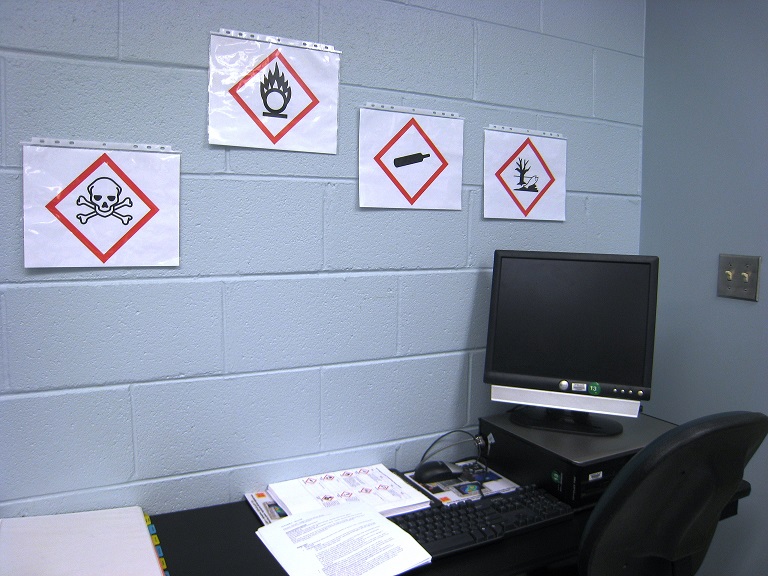Select one of the links below for more information.
Training
It is important that you have the required training before you start to work in the lab. Every laboratory worker is required to take Laboratory Safety Training annually. Also, if you work with certain biological materials, you may be required to take Bloodborne Pathogens training annually. These courses, provided by the Division of Occupational Health and Safety, are the minimum required training to begin working in a laboratory at the NIH. Please speak with your supervisor to arrange task-specific training. Additional course information is available here.
here.
The table below outlines the mandatory training courses, who is required to take the course, and when to take the course.
You may find the following supplemental training resources helpful:
back to the top
Globally Harmonized System (GHS), Hazard Signage, and Chemical Labeling
There are currently three official methods for labeling chemicals in the United States; the National Fire Protection Association's (NFPA) Hazard Identification System (NFPA Diamond) or the American Coatings Association's (ACA) Hazardous Materials Identification System (HMIS), and the United Nations' Globally Harmonized System (GHS). On March 26, 2012 OSHA adopted the GHS and incorporated it into the Hazard Communication Standard. The GHS will replace the NFPA and HMIS identification systems in workplaces. By December 1, 2013, all employers must train their employees about GHS. By December 1, 2015, all chemicals distributed in the U.S. must utilize the GHS labeling system. By June 1, 2016 all U.S. employers must be in full compliance with GHS.
The GHS will utilize standardized pictograms, standardized hazard statements, and standardized precautionary statements to alert workers to chemical hazards.
Pictograms
Pictograms are visual identifiers that will help employees readily recognize general hazard categories. A chemical may have multiple pictograms. OSHA Pictograms.
OSHA Pictograms.

Hazard Statements
Hazard Statements describe the nature of the hazard or hazards present and possibly the degree of the hazard for a chemical. A chemical may have multiple hazard statements. Each hazard statement is defined by OSHA and assigned a number. If you have personnel in your laboratory that do not speak or recognize English, you may use the assigned number of the hazard statement to identify the correct hazard statement in their language. Hazard statements can be physical, health, or environmental hazards.
Precautionary Statements
- Precautionary Statements alert employees to actions they must take to protect themselves from hazards associated with a chemical. Each precautionary statement is defined by OSHA and assigned a number. If you have personnel in your laboratory that do not speak or recognize English, you may use the assigned number of the precautionary statement to identify the correct precautionary statement in their language.
- Precautionary statements cover prevention, response, storage and disposal of chemicals.
-
 Precautionary Statements in English and European Languages
Precautionary Statements in English and European Languages 
Under the GHS, all chemical mixtures and compounds made in the laboratory will be required to have the following elements:
- Name, address and telephone number of person or company that prepared the mixture or compound
- Product identifier (name or chemical formula)
- Signal word, if applicable
- Danger (more severe)
- Warning (less severe)
- Hazard statements
- Precautionary statements
- Prevention
- Response
- Storage
- Disposal
- Pictograms
If you need assistance to identify the correct signal word, hazard statement, precautionary statement or pictogram, please contact your
 IC Safety and Health Specialist
IC Safety and Health Specialist.
Laboratory personnel should be familiar with all three labeling systems and be able to distinguish the differences between the systems. GHS numerical hazard ratings are, generally, the opposite rating of NFPA and ACA. For example,
in the GHS system acetaldehyde has a flammable rating of 1 but in the NFPA system it has a flammable rating of 4.
The following resources will help you learn the differences between the three labeling systems:
back to the top
Biological Safety
Below are some links that you may find useful in addition to the
DOHS biosafety website. If you need more specific information or help, please contact your
 IC Safety and Health Specialist.
IC Safety and Health Specialist.
back to the top
Safe Lab Equipment
The following websites provide useful information on the safe use of lab equipment:
Additional Information
back to the top
Emergency Procedures
Use the links below to help familiarize yourself with NIH emergency procedures. Speak with your PI about lab specific emergency procedures.
back to the top
OSHA and Lab Safety
The Occupational Safety and Health Administration (OSHA) has several laws and guidance documents that pertain to laboratory workers. The links below are a compilation of some of the pertinent resources from OSHA:
back to the top
